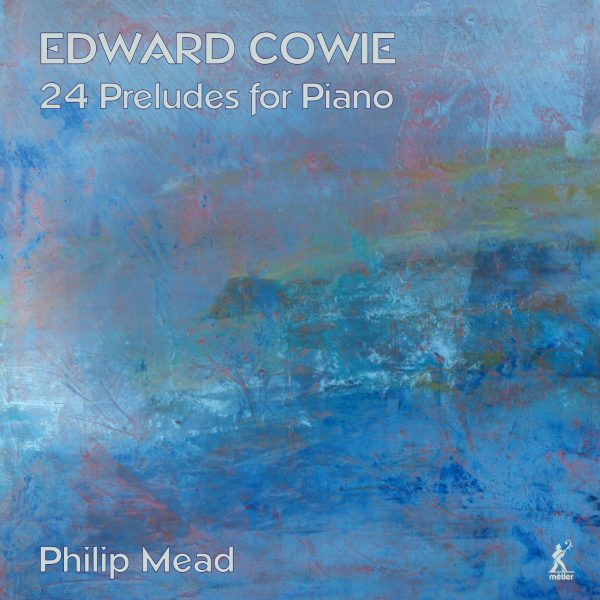Infodad
[reviewer has just reviewed Camden Reeves’s “Blue Sounds”]
The “blueness” is present in a different way on another Métier CD, this one focusing on piano music by Edward Cowie (born 1943) as played by Philip Mead. Unlike Reeves’ atonality, Cowie’s music in 24 Preludes for Piano is expressly tonal – following Bach’s key cycle in his Well-Tempered Clavier, but at the same time using a second organizational principle by grouping the preludes into four groups of six each. Those groups, designated Book 1 through Book 4, represent the old notion of “four elements,” the first being water – which is one place where the “blueness” comes in.
But Cowie goes beyond color sensitivity: he has a strong Impressionist streak in this music, so while following Bach’s keys faithfully, he also attempts in each of these 24 works to convey his impressions of specific places around the world. Thus, the “water” book includes, among other things, an Australian blowhole (C minor) and the Tennessee River in the U.S. (D minor), the former containing exclamatory eruptions and the latter with a sense of flow. Book 2 is devoted to air, including the blue sky at 35,000 feet above the Straits of Java (E major) and night breezes above the blue waters of Lake Eacham in Australia (B major). The “blue” elements in these works are implied obliquely rather than presented directly – these preludes are more about scene-setting than color specificity – but the coloristic elements of the music are everywhere present.
Book 3, focusing on earth, thus starts with another Australian scene, Uluru (long known as Ayers Rock), which stands out against the sky and is portrayed in a stately F-sharp major. This book also includes Glencoe (Scotland) in C-sharp minor and the Shenandoah Valley in Virginia in A-flat minor – again and again, Cowie presents strongly contrasting piano pieces that likely will be fully meaningful only to listeners as familiar with the specific locations as he is, but works whose differing moods are apparent even without knowing just what those moods indicate. The final book, with its focus on fire, actually opens with a passing reference to blue water by portraying sunrise over Loch Carron in Scotland (E-flat major). Perhaps inevitably, the penultimate prelude features fireworks (over Kassel, Germany, in F major), and the very last one is sunset over Dartmoor, Devon, England (F minor), the colors here unclear but certainly crepuscular. Cowie bites off a bit more than he can chew, or than most listeners can chew, in this set of preludes, because of the combination of a specific key sequence with its nod to Bach plus the ongoing Impressionism inherent in all two dozen pieces. But Mead certainly plays everything quite adeptly, bringing out contrasts among the works to good effect; and the music is well-made, well-thought-out, and colorful – in a variety of tones, both visual and auditory – from start to finish.
@divineartrecordingsgroup
A First Inversion Company
Registered Office:
176-178 Pontefract Road, Cudworth, Barnsley S72 8BE
+44 1226 596703
Fort Worth, TX 76110
+1.682.233.4978










![Listen to the full suite of Marcel Dupré’s Variations Sur un Noël, Op. 20 from Alexander Ffinch’s #Expectations release today! listn.fm/expectations [in bio]](https://scontent-dfw5-1.cdninstagram.com/v/t51.71878-15/588904367_2327488161082898_8709236950834211856_n.jpg?stp=dst-jpg_e35_tt6&_nc_cat=105&ccb=7-5&_nc_sid=18de74&efg=eyJlZmdfdGFnIjoiQ0xJUFMuYmVzdF9pbWFnZV91cmxnZW4uQzIifQ%3D%3D&_nc_ohc=H8WFKm530VcQ7kNvwHE1DTM&_nc_oc=Adm54STk6NpzntMS-GPZ_qLwRgZCpY0YAAPpmZY876OCGI1pWIKMuh7g8WO7QQmuDIk&_nc_zt=23&_nc_ht=scontent-dfw5-1.cdninstagram.com&edm=ANo9K5cEAAAA&_nc_gid=XdHyg-YeKH4vp-6d6IZI2w&oh=00_AfnHUYq1k4dDtD-2ffR5iV_k8DhcNon1ETcjgP9n7zSF9Q&oe=6956BAAA)

![“the ‘Manteca’ Paraphrase – a rare foray into the two-piano medium but here played double-tracked – exudes a panache of which Dizzy Gillespie would surely have approved.… [a] recital well worth investigating.” —Gramophone Magazine with high praise for Ophelia Gordon's debut release, Kapustin: Between the Lines!](https://scontent-dfw5-3.cdninstagram.com/v/t51.82787-15/598796470_18303255136283342_540941604740887837_n.jpg?stp=dst-jpg_e35_tt6&_nc_cat=108&ccb=7-5&_nc_sid=18de74&efg=eyJlZmdfdGFnIjoiRkVFRC5iZXN0X2ltYWdlX3VybGdlbi5DMiJ9&_nc_ohc=IC4zZ7tcpb8Q7kNvwHjEtGQ&_nc_oc=AdkCS9IFcK2e8_hUQY_l_5j2GzId0_j0qJODcEsTau7dx8F3lQuTXNxTWPFdFuMZ7nM&_nc_zt=23&_nc_ht=scontent-dfw5-3.cdninstagram.com&edm=ANo9K5cEAAAA&_nc_gid=XdHyg-YeKH4vp-6d6IZI2w&oh=00_Afk-VIhOi93cVOHoy_nuV3fW7lpx8gEBSg4jPGoaHYR7vQ&oe=69569504)